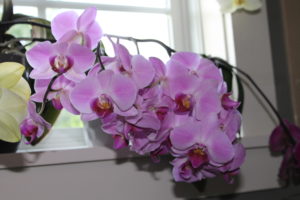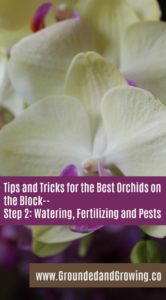You’ve got your new orchid home, in a great location, now how do you keep it alive and thriving?
This post contains affiliate links.
“You know, it’s amazing what a little fertilizer and water can do if you remember to use them.”
This was my friend’s response when I commented on a plant she had in her office that looked particularly amazing. We had a good laugh but the reality was this statement was pure truth for both of us.
We were both meeting ourselves coming and going and loved our gardens and houseplants, but more often than not things died at our houses from plan ol’ neglect.
Most houseplants, including orchids, die once you get them home from being overwatered.
But not at our homes. We killed them by being way too busy and forgetting we even had the plants to begin with. The irony of the situation is both of us were horticulture educators, and our job was to teach people how to grow plants! Do as I say not as I do I guess.
No matter which way you fall in your watering and/or fertilizing habits, these are some tips that I’m sure have saved the life of a plant or two at my house.
Watering
- Overwatering orchids is easy to do and probably the biggest reason they die at home. Their roots are adapted to absorb water quickly from rain showers. Orchid roots need to dry out between waterings, or they will rot. Make sure that plants do not sit in water; empty saucers or decorative pots after watering.
- Orchids generally love humidity. They can absorb some of the water carried by humid air through their roots. My Phalaenopsis thrive in a southwest-facing bathroom window where they get good light and plenty of humidity. Have a window with great light but it’s not in the bathroom? No problem—use a humidifier. Most of our homes are way too dry during the winter anyway. Everyone will benefit from a humidifier, not just the orchids. Trays filled with water and pebbles to keep the orchids from sitting in water is another option to increase the humidity immediately around your orchids.

Phalaenopsis orchids blooming in my bathroom window.
- If you don’t give your orchids enough water, first the roots will shrivel and die, and the rest of the plant will follow a short time after that. Fortunately for some orchid species there is a lot of wiggle room between too much water and not enough. I have read that Phalaenopsis thrive on “benign neglect”. In other words, Phalaenopsis prefer not to be fussed over; it’s ok to forget about them at least for a short time. Let them dry out between waterings, especially during the winter months. My Phalaenopsis in the bathroom get a thorough watering maybe twice per month; the humidity of the bathroom carries them through the rest of the time.
- Keep in mind that an orchid’s water needs change throughout the year. There is some clever marketing attached to Phalaenopsis that suggests watering with a set number of ice cubes each week. At first glance I thought it was a great way to avoid overwatering, but it doesn’t typically take into account that the plant may need more water in the warmth of spring and summer, and less water during the cooler winter months. Plus as your plant grows larger it will need more water as well. Watering with ice cubes could also potentially harm the roots if the ice directly contacts them. Orchids ARE tropical plants after all. They aren’t equipped to deal with ice.
Now I have had several people tell me that using ice cubes to water was the first time they were able to keep a Phalaenopsis alive more than a couple of months. If this is your experience, by all means go with it. If it ain’t broke, don’t fix it. Just keep in mind you may need to adjust how many ice cubes you use as seasons change and the plant grows.
So you’ve figured out how to water your orchids without too much trouble, but have you fertilized it? A good way to get completely overwhelmed and confused about growing orchids is to look online about using fertilizers. I have witnessed otherwise calm and collected, sane people come positively unglued debating the merits of various fertilizers and timings and rates where orchids are concerned. It doesn’t have to be this difficult folks.
Fertilizing
- Water-soluble fertilizers make it easy to fertilize while watering. There is no one “perfect” orchid fertilizer—even a general-purpose fertilizer can produce amazing results if used regularly. I’m a big fan of the “weakly, weekly” method (or however often you need to water). Mix your chosen fertilizer at 25% (or less) of the label directions and use for each watering. Personally, I can remember to do this much more consistently than fertilizer recommendations that change with the season or depend on whether the plant is in flower or not. A weak fertilizer solution can be used even on plants in flower with no ill effects.
Pests
- The two most common pests found on orchids are scale insects and mealybugs. Both can kill an orchid if left unchecked. Scale insects have a hard shell and range in color from yellow-tan to dark brown and resemble a droplet stuck to a stem, flower or leaf. Mealybugs are white and look like tufts of cotton. They like to hide on leaf undersides, and flowers. Both can be found on orchid roots largely due to the open airy nature of orchid planting mix. One reason I lost my big orchid collection to mealybugs was I didn’t realize they can infest the roots. Inspect plants thoroughly before buying and regularly once you get them home.
- Small infestations of either pest can be controlled with a cotton swab dipped in rubbing alcohol. Larger infestations respond well to insecticidal soap applied regularly. Insecticidal soap does not kill the eggs so you need to apply it often, according to label directions to get good control. Keep in mind if you want to use a commercial insecticide, it needs to say on its label that it’s ok for indoor use. Even if it can be used indoors, use caution with insecticides especially if you live with children and/or pets.
- I’ve had success using insecticidal soap on orchid pests, but I really just wanted to avoid getting them in the first place. Putting orchids outside for the summer does help by changing the environment to one that the pests don’t like as much, but the orchids do. As the orchids grow stronger, they are less likely to be attacked by pests. But despite this I still would fight scale and mealybugs, especially during the winter months.
Orchid Myst
- I saw an advertisement for a product called Orchid Myst that made all sorts of promises for the best orchids ever and said it was the #1 orchid care product in the UK. I bought it out of a combination of desperation and curiosity particularly since it made some claims about repelling insect pests.

Orchid Myst fertilizer analysis: 0.0026% Nitrogen, 0.0017% Phosphorus, 0.0030% Potassium– almost plain water!
- There was no information on the label or online as to the specific ingredients; this made me doubt it would work at all. It said it contained fertilizer but the original bottle I bought didn’t give a breakdown of how much nitrogen, phosphorus and potassium. Newer bottles now show a breakdown of the fertilizer percentages, and honestly, it might as well be pure water.
- But I have had remarkable results with it. I have had no pest problems since I started using it three years ago, which completely blows my mind. I have always fought scale and mealybug when I’ve grown orchids. There were a few scale insects on one plant after I brought it home, but I have not seen any more after applying Orchid Myst regularly.
- The product has a familiar scent to it. I don’t know for sure if I’m correct since there is no specific ingredient list, but those of you into essential oils would probably recognize the scents of tea tree (Melaleuca) and Eucalyptus. Both have been shown to repel insects, which probably explains my incredible lack of pest problems since I started using the product.
- It also reportedly contains humic and fulvic acids, breakdown products of decomposing plant material which supposedly act as growth enhancers for plants. Unfortunately I could not find much research proving or disproving this claim, though there are other fertilizer companies including these acids in their formulations for their supposed plant growth boosting properties. But I will say my plants are growing and flowering better than any orchids I’ve ever owned. I’m not sure it’s all due to Orchid Myst but I did see a positive difference when I started using it.
Sooner or later just keeping your orchid alive and kicking won’t cut it anymore. Let’s face it, you bought it because of the flowers.
How hard is it to get an orchid to rebloom?
Is it one of those disposable plants that aren’t worth the time and effort? Read the next post in this series and learn what has worked to get my orchids (mostly Phalaenopsis) to rebloom.
If you liked this post, please subscribe to Grounded and Growing today and receive your copy of “15 Tips to Become a '15 Minute Gardener'” so you can spend less time working ON your garden and more time enjoying being IN your garden.! It’s absolutely free. When you join the Grounded and Growing community, you’ll finally take the garden off your “To-Do” list and allow yourself time to enjoy your garden and savor the peace and serenity there. I tell subscribers about new posts as soon as I hit ‘publish’ and send weekly-ish updates on what’s going on in my garden– good, bad AND ugly.

All Rights Reserved. © 2017 Jennifer Schultz Nelson
[…] infestation. I guess I really didn’t know as much as I thought I did. Like I mentioned in my last post, I had no idea mealybugs could infest an orchid’s roots and kill the plant without being […]